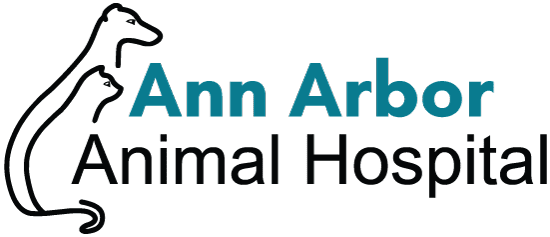
by Kerry McKinney, DVM
As a general rule, most of us in the veterinary profession are familiar with hard work and championing the underdog. We were the kids who rescued baby birds, nursed broken turtles, bottle-fed orphaned kittens, happily mucked stalls at 5:00 a.m. in February in exchange for horse board, and grew up to adopt three-legged dogs and Feline Leukemia-positive cats. The alternative to trying our best to treat Iris’ pyothorax was giving up. Definitely not an option.
Meaghan and Iris arrived back at Ann Arbor Animal Hospital from MSU’s College of Veterinary Medicine later that evening. In addition to taking care of our four-legged patients, the other thing we do at AAAH is take care of each other. One look at Meaghan and it was clear that after a worried day on the road and in hospitals, she was exhausted and hadn’t eaten. With a little effort and a bit of a stern “mom” voice, Meaghan was convinced to leave. Her co-worker, Aimee Bell, took her out for a break and a meal while Iris was assessed and prepped.
By the time they returned, Iris was ready for a brief anesthesia during which she had sterile tubes surgically inserted between her ribs and advanced into each side of her chest to allow flushing and drainage as needed. In addition to managing the infection we also had to keep her comfortable, maintain sterility and get enough nutrition into her to allow her to heal. Fortunately our little “wolf” hound took care of the last item herself as soon as her fever started to come down. Thank goodness for puppy appetites!
The next week was truly a team effort of 24-hour care and monitoring. Iris’ progress and setbacks were detailed in rounds twice a day as each ICU shift swapped duties. Text messages flew at all hours among ICU DVMs as we double-checked each other on small changes and decided the best next steps. And she certainly had every benefit “therapeutic watching” could offer!
Concerns about her progress and “what might be in there” ultimately did result in a CT scan which thankfully appeared free of both a sliver and lung abscess. Gradually, the appearance and amount of fluid withdrawn from Iris’ chest every 4 to 6 hours improved. Her fever resolved and instead of lying lethargically in her ICU cage she started getting excited at walk times. The final culture and sensitivity results from MSU were still pending and we had to decide on oral antibiotics. One of the antibiotics we were using can adversely affect cartilage development in young, growing dogs. Assuming she survived, we were concerned Iris’ future as an agility dog might be compromised. We discussed the risk and benefit with Meaghan and opted to continue that medication for another five days.
One week later, I removed her chest tubes. And watched. And watched some more. Then she went home for Meaghan to watch. A lot.
Since then, Iris has steadily improved and rechecks have been wonderfully unremarkable. She’s up a few pounds and was recently allowed off leash for the first time to begin some gentle exercise. If you stop in on the right day, you may find she’s accompanied Meaghan to work in our Drive-Thru. Iris isn’t entirely out of the woods yet, but we’re hoping she’ll be racing across a field sometime between Memorial Day and Independence Day. Check back for updates!
Recent Posts
About Us
Ann Arbor Animal Hospital is a locally-owned animal hospital operating for over 90 years in Ann Arbor, MI.
